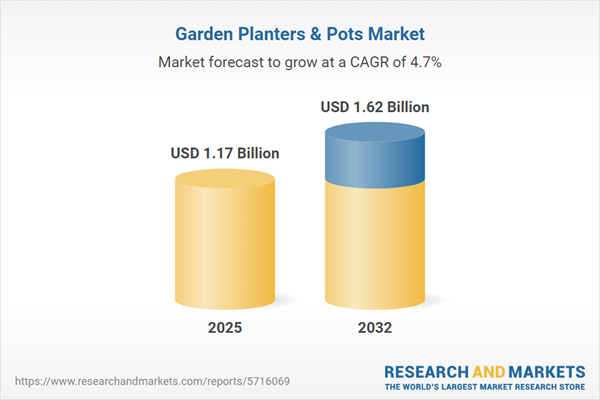Speak directly to the analyst to clarify any post sales queries you may have.
The garden planters and pots market is evolving rapidly, influenced by sustainability initiatives, digital commerce, and new consumer preferences. Purpose-driven innovation and resilient supply chains are driving competitive differentiation within the global outdoor décor sector.
Market Snapshot: Growth Trajectory and Opportunities in the Garden Planters & Pots Market
The Garden Planters & Pots Market grew from USD 1.12 billion in 2024 to USD 1.17 billion in 2025 and is projected to maintain a CAGR of 4.72%, reaching USD 1.62 billion by 2032. This sustained market expansion is driven by factors such as design innovation, rising eco-consciousness, and shifts in consumer lifestyles. As outdoor living increases, planters and pots transition from basic utility to essential elements of urban greening and experiential home environments. Heightened competition and shortened product development cycles are motivating industry stakeholders to refine portfolios, build efficient supply chains, and improve digital retail strategies.
Scope & Segmentation: Comprehensive Landscape of the Garden Planters & Pots Industry
- Material Types: Ceramic (glazed and terra cotta), Concrete (fiber reinforced and precast), Fiber (bamboo fiber, resin wicker), Metal (cast iron, steel), Plastic (injection molded, rotational molded), Wood (natural and treated)
- Container Types: Hanging baskets (bracket and chain), Planter bags (fabric and grow bag), Planter boxes (raised bed, standard), Decorative pots, Nursery pots, Troughs (stone, wooden), Window boxes
- Distribution Channels: Garden center, home improvement store, specialty store, supermarket, hypermarket, direct-to-consumer online, third-party e-commerce
- End Users: Commercial (hospitality, retail showrooms), Institutional (educational institutes, municipal agencies), Residential (DIY homeowners, landscape contractors)
- Shapes and Sizes: Custom decorative designs (designer series, themed collections), oval, rectangular, round, square, with sizing spanning extra large, large, medium, mini, and small
- Price Tiers: Economy, mid-range, premium options catering to varied budget segments
- Geographies: Americas (North America, Latin America), Europe, Middle East & Africa, Asia-Pacific, with further regional breakdowns
Key Takeaways for Senior Decision-Makers
- Manufacturers are integrating recycled, biodegradable, and low-impact materials to meet rising sustainability requirements and consumer expectations.
- Digital transformation is accelerating, with smart planters featuring sensors and connected features emerging alongside immersive online retail experiences.
- Strategic alliances and vertical integration, including online-offline hybrid retail channels, are strengthening market presence and customer loyalty.
- Customization, modular design, and refurbishment programs enable companies to address niche consumer needs and promote circular economy models.
- Multiple end user segments, from hospitality to municipal and DIY consumers, require tailored product assortments and distribution strategies to realize market potential.
- Supply chain realignment and product bundling help mitigate impacts of geopolitical shifts, such as tariffs and trade regulations.
Tariff Impact: Navigating Policy Disruption in 2025
The introduction of new U.S. tariffs in 2025 has led suppliers to diversify sourcing, nearshore production, and renegotiate logistics. This environment has encouraged businesses to optimize inventory management, bundle value-added offerings, and curate differentiated product assortments. Companies that adapt quickly by reconfiguring their supply networks and innovating within these constraints demonstrate market resilience and seize new opportunities despite policy-induced disruptions.
Methodology & Data Sources
This report applies a rigorous approach. Primary insights are gathered from in-depth executive and product designer interviews and broad-based end user surveys. Secondary sources include trade publications, patent reports, and regulatory documents. Data triangulation and expert validation underpin the accuracy of market segmentation and trend mapping.
Why This Report Matters for Strategic Decision-Making
- Enables executives to anticipate and capitalize on evolving material, technology, and consumer trends in the garden planters and pots market.
- Supports resilient sourcing and channel strategies in the context of regulatory and supply chain transitions.
Conclusion
The Garden Planters & Pots Market combines sustainability, design, and digital innovation within a robust value chain. Senior stakeholders equipped with actionable, data-driven insights will be best positioned to drive targeted growth and long-term success in this changing industry landscape.
Additional Product Information:
- Purchase of this report includes 1 year online access with quarterly updates.
- This report can be updated on request. Please contact our Customer Experience team using the Ask a Question widget on our website.
Table of Contents
3. Executive Summary
4. Market Overview
7. Cumulative Impact of Artificial Intelligence 2025
Companies Mentioned
The companies profiled in this Garden Planters & Pots market report include:- The Home Depot, Inc.
- Lowe's Companies, Inc.
- Walmart Inc.
- Amazon.com, Inc.
- Kingfisher plc
- Groupe ADEO
- Canadian Tire Corporation, Limited
- OBI GmbH & Co. Deutschland KG
- ACE Hardware Corporation
- True Value Company
Table Information
| Report Attribute | Details |
|---|---|
| No. of Pages | 195 |
| Published | October 2025 |
| Forecast Period | 2025 - 2032 |
| Estimated Market Value ( USD | $ 1.17 Billion |
| Forecasted Market Value ( USD | $ 1.62 Billion |
| Compound Annual Growth Rate | 4.7% |
| Regions Covered | Global |
| No. of Companies Mentioned | 11 |









